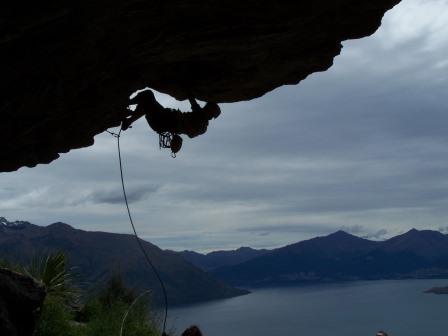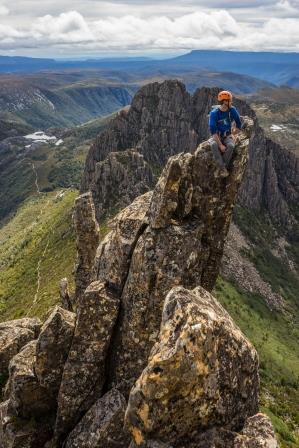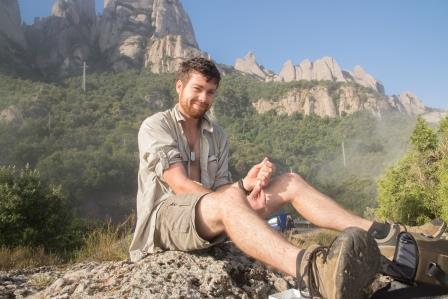
Andrew climbing at Wye Creek in New Zealand
Photo: Andrew and Scott Godwin
Australian brothers Andrew, 30 and Scott, 37, are taking on the El Capitan climb at Yosemite National Park in California in September 2019. Andrew is an HFA youth leader. HFA will be following their preparation and adventures on Factored In and our social media.
Andrew and Scott both have severe haemophilia A, with associated degenerative osteoarthritis of the ankles. They discovered rock climbing as an activity that offered a way to experience the outdoors without the physical barriers associated with many mainstream sports.
‘The confidence that I’ve built from knowing that I can deal with the risks and challenges of climbing situations has helped me through plenty of other challenges in life. Climbing has also guided some major life decisions,’ said Scott

Scott on Cradle Mountain traverse
Photo: Cameron Semple
‘For me the most challenging part of climbing has always been about mental self-control,’ said Andrew. ‘In order to be able to climb well you must control both your body and your mind. At times this has meant enduring adverse weather like being on a climb at Pierces Pass in winter and having ice crystals rain down on top of you, or forcing myself to focus through dehydration and heat stress climbing at Montserrat in Spain, or dealing with terrifying loose rock on screen slopes in the Dolomites of Italy. All of these things are small challenges that must be overcome to continue to improve and fully appreciate the experience of rock climbing.’

Andrew – Pre-climbing factor VIII infusion, Montserrat, Spain
Photo: Andrew and Scott Godwin
Yosemite is a world-famous national park located in the Sierra mountain range in California. The best-known part of the park is Yosemite Valley, which features huge vertical granite walls on both sides. Yosemite Valley has been a mecca for rock climbers since the early 1950s. Much of the techniques, equipment and culture of modern climbing evolved in Yosemite. The valley is best known to climbers as the home of 'Big Wall' climbing, which refers to climbing long routes on vertical walls that take more than one day to complete. Nights are spent living on the wall, either on small natural ledges, or in 'portaledges' which are a kind of hanging tent that is suspended from the wall.
While there are many rock formations in Yosemite Valley that lend themselves to big wall style climbing, the biggest and most famous is El Capitan (the Captain). It's roughly a kilometre high, and almost completely vertical from the base to the summit. El Capitan was first climbed in 1958 via a route called 'The Nose' because it follows the huge nose-shaped prow straight up the middle of the highest part of the wall. Since then, there have been a number of other climbing routes established on El Capitan, but the Nose is still the most coveted by climbers from around the world. It's highly technical and involves climbing a series of crack systems, using ropes and gear both to prevent falls and to aid in upward progress. Most climbers take between 3 and 5 days to climb the Nose.
‘Climbing El Capitan has been a dream of mine since I started climbing, but its only really become a specific goal in the last five years,’ explained Andrew. ‘In 2013 I spent a few weeks climbing in Yosemite with my partner Laura. We climbed a lot of the easier routes in the Valley, but at the time we weren't really ready for the bigger walls. One of the climbs we attempted involved spending a night on the wall, but we had to retreat when we realised that we didn't have the technical skills to get up a particularly difficult overhanging section of rock. Since that experience I've spent a lot of time learning the skills necessary to climb big wall routes. In the back of my mind I've considered all the climbing I've done for the last several years to be training for returning to Yosemite to climb El Capitan.’
Over Easter 2019 Andrew and Scott did a training climb at Ozymandius at Mt Buffalo National Park in Victoria. It’s located on the north wall of the Mt Buffalo gorge, which is 300 metres high.
{^youtubevideo|(width)425|(height)264|(rel)True|(autoplay)False|(fs)True|(url)https://www.youtube.com/watch?v=jDsOmJDYj_4|(loop)False^}
Check out the video of Andrew and Scott's training
'Planning for the training climb and Yosemite, and especially with haemophilia, can be logistically complicated – planning is important,’ said Scott. ‘Having a plan for managing our factor supplies and infusions will also be critical. I’ve learnt from personal experience that I need daily infusions of factor VIII to prevent bleeds when I’m doing something physically strenuous like climbing. We’ll bring enough supplies with us to ensure that we avoid bleeds, plus extra in case of emergency. Both of us are used to performing intravenous infusions, so we will be capable of treating each other in an emergency.’
We will post updates regularly on
Haemophilia Foundation Australia acknowledges the Traditional Owners and Custodians of Country throughout Australia, the land, waters and community where we walk, live, meet and work. We pay our respects to Elders past and present and extend that respect to all Aboriginal and Torres Strait Islander peoples.
Sign up for the latest news, events and our free National Haemophilia magazine